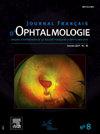Intravitreal injection of faricimab to treat macular and retinovascular diseases in Nigerians: Early real-world experience
IF 1.2
4区 医学
Q3 OPHTHALMOLOGY
引用次数: 0
Abstract
Introduction
Faricimab is a novel bispecific antibody for treating retinovascular diseases. Nigerians were not included in the pivotal approval studies; therefore, its performance in Nigerians is unknown.
Purpose
To report indications, outcomes and safety of intravitreal faricimab (IVF) in Nigerians.
Study setting
Single tertiary care ophthalmology hospital.
Material and Methods
Retrospective review of eyes documented to have received at least one IVF injection from January to August 2024, with no exclusions. Information retrieved from case records includes patient demographics, indication, previous intravitreal injections, number of IVF injections, visual outcome and central subfield thickness (CST), before and after IVF injection.
Results
A total of 77 IVF injections were administered to 39 eyes of 31 patients; mean age 65.69 years (± 10), ranging from 48 to 80 years. Fifteen were male (17 eyes), and 16 were female (22 eyes). The most common indications for treatment were neovascular age-related macular degeneration (nAMD) in 13 eyes (33%) and diabetic macular edema (DME) in 10 eyes (25.6%). For all eyes, visual acuity improved from a baseline LogMAR score of 0.90 (± 0.57) to 0.88 (± 0.64) after the first injection, and 0.74 (± 0.61) after the final injection. Central subfield thickness (CST) decreased from 403.80 microns (± 208.61) to 303 microns (± 191.07). In treatment-naïve eyes (n = 19), vision improved from a LogMAR score of 0.87 (± 0.55) to 0.66 (± 0.45) after the final injection (P = 0.006), and CST decreased from 433.94 microns (± 258.58) to 310.45 microns (± 206.48) (P = 0.010). In previously treated (switch) eyes (n = 20), visual acuity improved from 0.91 (± 0.60) to 0.81 (± 0.74) (P = 0.019), and CST decreased from 376 microns (± 153.48) to 297.53 microns (± 186.19) (P = 0.004). There were no adverse reactions reported following the injections.
Conclusion
IVF was safe and effective for treating nAMD, DME and other retinovascular diseases in Nigerians in this pilot study. Outcomes of large sample size studies are expected.
Introduction
Le faricimab est un nouvel anticorps bispécifique, pour le traitement des maladies rétinovasculaires. Les Nigérians n’ont pas été inclus dans les études pivots d’approbation, par conséquent, ses performances chez les Nigérians sont inconnues.
Objectif
Rapporter les indications, les résultats et la sécurité du faricimab intravitréen (FIV) chez les Nigérians.
Contexte de l’étude
Hôpital ophtalmologique tertiaire unique.
Matériel et méthodes
Examen rétrospectif des yeux documentés comme ayant reçu au moins une FIV de janvier à août 2024, aucune exclusion. Les informations extraites des dossiers médicaux comprennent les données démographiques des patients, l’indication, les injections intravitréennes précédentes, le nombre d’injections de FIV, le résultat visuel et l’épaisseur du sous-champ central (CST), avant et après l’injection de FIV.
Résultats
Au total, 77 FIV ont été administrées à 39 yeux de 31 patients; âge moyen de 65,69 ans (± 10), allant de 48 à 80 ans. Quinze étaient des hommes (17 yeux) et 16 étaient des femmes (22 yeux). Les indications thérapeutiques les plus fréquentes étaient la dégénérescence maculaire néovasculaire liée à l’âge (DMLAn) dans 13 yeux (33 %) et l’œdème maculaire diabétique (OMD) dans 10 yeux (25,6 %). Pour tous les yeux, l’acuité visuelle s’est améliorée, passant d’un score LogMAR initial de 0,90 (± 0,57) à 0,88 (± 0,64) après la première injection, et à 0,74 (± 0,61) après la dernière injection. L’épaisseur du sous-champ central (CST) a diminué de 403,80 microns (± 208,61) à 303 microns (± 191,07). Dans les yeux naïfs de traitement (n = 19), la vision s’est améliorée d’un score LogMAR de 0,87 (± 0,55) à 0,66 (± 0,45) après l’injection finale (p = 0,006), et le CST est passé de 433,94 microns (± 258,58) à 310,45 microns (± 206,48) (p = 0,010). Dans les yeux précédemment traités (switch) (n = 20), l’acuité visuelle s’est améliorée de 0,91 (± 0,60) à 0,81 (± 0,74) (p = 0,019), et le CST est passé de 376 microns (± 153,48) à 297,53 microns (± 186,19) (p = 0,004). Aucune réaction indésirable n’a été signalée après les injections.
Conclusion
La FIV s’est avérée efficace et sûre pour traiter la DMLA néovasculaire, l’œdème maculaire diabétique et d’autres maladies rétinovasculaires chez les Nigérians dans cette étude pilote. Les résultats d’études sur de grands échantillons sont attendus.
法昔单抗玻璃体内注射治疗尼日利亚黄斑和视网膜血管疾病:早期现实世界经验
导言法利单抗是一种治疗视网膜血管疾病的新型双特异性抗体。材料与方法回顾性分析 2024 年 1 月至 8 月期间至少接受过一次 IVF 注射的眼部记录,无排除病例。从病例记录中获取的信息包括患者的人口统计学特征、适应症、既往玻璃体内注射情况、IVF注射次数、IVF注射前后的视觉效果和中央子场厚度(CST)。结果31名患者的39只眼睛共接受了77次IVF注射;平均年龄65.69岁(±10),从48岁到80岁不等。男性 15 例(17 眼),女性 16 例(22 眼)。最常见的治疗适应症是新生血管性老年黄斑变性(nAMD)13 眼(33%)和糖尿病性黄斑水肿(DME)10 眼(25.6%)。首次注射后,所有眼睛的视力都从基线 LogMAR 分数 0.90(± 0.57)提高到 0.88(± 0.64),最后一次注射后提高到 0.74(± 0.61)。中央子场厚度(CST)从 403.80 微米(± 208.61)降至 303 微米(± 191.07)。在未经治疗的眼睛(n = 19)中,最后一次注射后视力从 LogMAR 评分 0.87 (± 0.55) 提高到 0.66 (± 0.45)(P = 0.006),CST 从 433.94 微米(± 258.58)下降到 310.45 微米(± 206.48)(P = 0.010)。在之前接受过治疗(切换)的眼睛(n = 20)中,视力从 0.91(± 0.60)提高到 0.81(± 0.74)(P = 0.019),CST 从 376 微米(± 153.48)下降到 297.53 微米(± 186.19)(P = 0.004)。结论 在这项试点研究中,IVF 对治疗尼日利亚人的 nAMD、DME 和其他视网膜血管疾病安全有效。导言法利单抗是一种治疗视网膜血管疾病的新型双特异性抗体。研究背景单家三级眼科医院材料与方法回顾性审查2024年1月至8月期间至少接受过一次IVF治疗的眼睛,无排除病例。从病历中提取的信息包括患者的人口统计学特征、适应症、既往玻璃体内注射情况、IVF注射次数、IVF注射前后的视觉效果和中央子场厚度(CST)。结果31名患者的39只眼睛共接受了77次IVF注射;平均年龄为65.69岁(±10),从48岁到80岁不等。其中男性 15 例(17 眼),女性 16 例(22 眼)。最常见的治疗适应症是新生血管性老年黄斑变性(nAMD)13 眼(33%)和糖尿病性黄斑水肿(DME)10 眼(25.6%)。所有患者的视力都有所改善,首次注射后视力从最初的 LogMAR 评分 0.90 (± 0.57) 降至 0.88 (± 0.64),最后一次注射后视力降至 0.74 (± 0.61)。中央子场厚度(CST)从 403.80 微米(± 208.61)降至 303 微米(± 191.07)。在未接受治疗的眼睛(n = 19)中,最后一次注射后视力从 LogMAR 评分 0.87 (± 0.55) 提高到 0.66 (± 0.45)(p = 0.006),CST 从 433.94 微米(± 258.58)下降到 310.45 微米(± 206.48)(p = 0.010)。在之前接受过治疗(切换)的眼睛(n = 20)中,视力从 0.91(± 0.60)提高到 0.81(± 0.74)(p = 0.019),CST 从 376 微米(± 153.48)提高到 297.53 微米(± 186.19)(p = 0.004)。结论 在这项试点研究中,IVF 被证明在治疗尼日利亚人的新生血管性黄斑变性、糖尿病性黄斑水肿和其他视网膜血管疾病方面是有效和安全的。我们还在等待涉及更多样本的研究结果。
本文章由计算机程序翻译,如有差异,请以英文原文为准。
求助全文
约1分钟内获得全文
求助全文
来源期刊
CiteScore
1.10
自引率
8.30%
发文量
317
审稿时长
49 days
期刊介绍:
The Journal français d''ophtalmologie, official publication of the French Society of Ophthalmology, serves the French Speaking Community by publishing excellent research articles, communications of the French Society of Ophthalmology, in-depth reviews, position papers, letters received by the editor and a rich image bank in each issue. The scientific quality is guaranteed through unbiased peer-review, and the journal is member of the Committee of Publication Ethics (COPE). The editors strongly discourage editorial misconduct and in particular if duplicative text from published sources is identified without proper citation, the submission will not be considered for peer review and returned to the authors or immediately rejected.

 求助内容:
求助内容: 应助结果提醒方式:
应助结果提醒方式:


